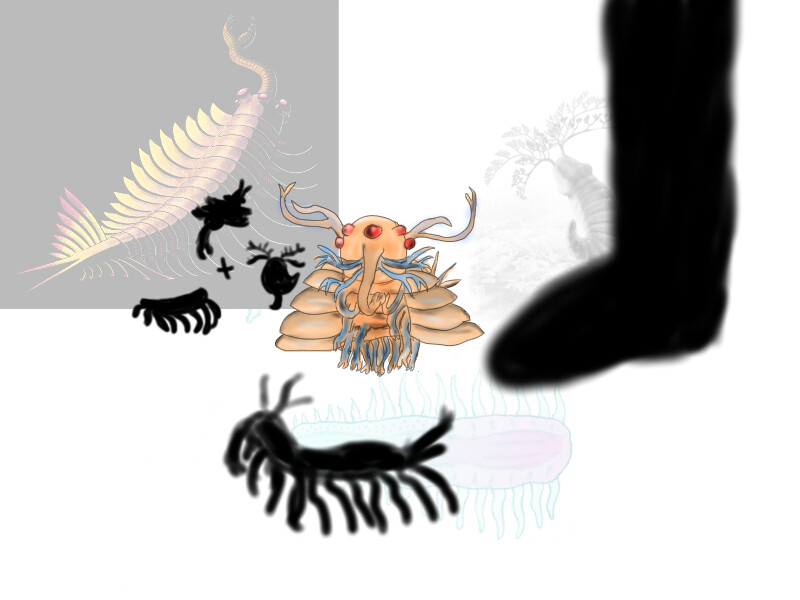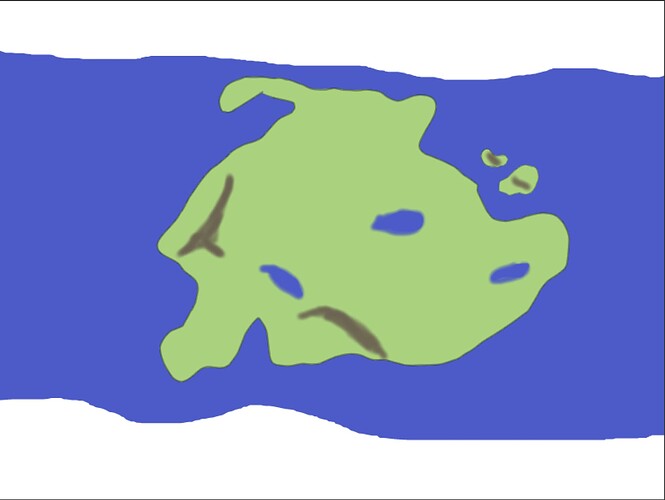Hello to you all!
Some know, some don’t, but I think it’s really time to share it with you all here:
More than a month ago I started a community project and it was quite hidden from view until recently and I think it’s time to share it with you especially.
And what is this project about?
Let’s say this is the alternate version of this forum game:
But the idea behind it is much older than that:
It all started with this infamous painting:
The Herpelenurora: (Herpetogaster X Gelenoptron X Utaurora)

From him, published more than a year and a half before, things started to move that led to the birth of two things: the forum game mentioned earlier, and the community project I will talk about today.
This project is literally: the evolution of chimeric creatures on another planet.
At length… I recommend that you go to this website that I built for the project:
This project has been around for a month, as said, and people have already submitted their “pioneers” to the project.
In his original idea he was supposed to start on January 5th.
But then an offer came from me to open a chat in a certain place and it kind of blew up (at least at the level I’m familiar with) and there was a desire to add more chimeras to the list, but the closing time had already passed by the time it opened.
But that’s why, after talking about others, it seems that I’m going to open the submission for another week or so from now.
So let’s say this:
I think you also have the opportunity to submit chimeras to the project before Bow really starts officially (which was supposed to be, but no one submitted until then that it was supposed to start, so it’s still fine in terms of definition)
There was a painting I posted the day before, so that was for this project and I plan to complete it very soon.

So.. how does the submission work?
Here are points posted elsewhere, I just copied them here:
Original opening
This document is a top secret intended only for the inner circle of [[censored]]. A distributor to foreign sources will be severely punished in [[censored]]. you have been warned.
To anyone who sees this document,
Are you bored by those inferior creatures of the earth’s inhabitants? Fossils and living genetic reconstructions of dinosaurs not satisfying you anymore? Janna-2b’s alien zoo displays not getting your enthusiasm?
Have you dreamed of creating the perfect creature according to your imagination? Braver than a badger, stronger than a T. Rex and more charismatic than a panda?
Look no further! You can find all this at:
Chimarion!
A secret terraform world that belongs to the inner circle of [[Censored]] (don’t tell it to anyone but yourselves and the recipients of this invitation/document) that is clean and sterile of all the nonsense the universe offers and offers your perfect place to create your chimera!
You heard me right! C.H.I.M.E.R.A!
A hybrid creature made up of different creatures, named after the Greek mythological creature, with a lion’s head, a goat’s head, a snake’s head and in some sources also a dragon’s head.
But here, since we have the genetic engineering capabilities, advanced knowledge, genetic reconstruction and, of course, optimal growing conditions for each type of creature (and of course a number of secret technologies that we try to hide from the system), the dream of creating your perfect creature and existing and known creatures is a dream that comes true!
Almost.
Due to some technical factors, limitations and prevention of unintended results from genetic play, we can only guarantee creatures for which we have genetic information, in order to prevent such problems. But even with these limitations, we can guarantee that the selection is so vast that you can create the creature of your dreams!
You dream the creature of your dreams, we create it for you and then move it to a safe place where it can live in freedom without interference (if ethics are ignored of course) on our planet Chimarion!
If you are interested in creating the creature of your dreams, here follow the following instructions:
- You can choose up to 4 earth creatures (living or extinct), with a minimum of 2, to create your chimera.
- From each creature you have chosen, you can specify which features you want to “lend” to your chimera. For example: the ability to digest grass of a cow or the strong skull of Dunkleosteus or anything you can think of. The limit is only an imagination and the creature you borrow it of course.
- If you are interested, you are able to choose which behavior it will take form, depending on the creatures you have chosen for your chimera
- After you finish, you send what you have created to us and we will make the creature of your dreams come true
Of course we have some special limitations, for obvious reasons above, but we will list them here:
- We do not accept chimeras that contain ape samples. We don’t want to breed a chimera that has human traits, it’s already reaching a limit that we don’t want to enter
- We do not accept samples from single-celled prokaryotic organisms, as they are too genetically different from a multi-celled eukaryotic organism.
- You are not limited to one chimera, but we prefer not to create too many, our amount of resources is limited.
Once all the criteria are in your submission, all that’s left to do is wait for your dream creature to be created and grow large enough and we’ll bring them to you.
You dream, we create, Team Chimerion
“Have you seen this document?”
“Yes, I’ve seen more than enough to see how much playing gods gets them. We don’t know how many Chimeras this team has created or even the location of this planet, ‘Chimerion’, and their ability to destroy evidence is unbelievably amazing. They beat us.”
“So what are we going to do with all this?”
“Unfortunately, let’s just pray that these disgusting creatures created for fun don’t suffer too much”
And what it means, that life… finds a way. What they don’t know and we here know is one thing - every creature we know that has genes changes over time, and these chimeras, abandoned on the planet Chimarion, are subject to the effects of evolution and nature. And this is the essence of this foreign project that arose from a strange idea of one story for another forum game that was lost in time (because I lost the information) and I thought to myself after seeing the things here, I should not try to do this as a community project.
This idea came to me about a year ago at least with another painting that those who know me know about. At first I thought of it as a forum game (which already exists elsewhere and is currently quite successful) but when I saw things here, I think that this version is more suitable for the strange and somewhat dark nature that this idea brings and hence this project was created.
It will be interesting to see how it grows and I will try to invest in it too if something missing (most likely plants of fungi chimera).
I suppose there is an excess demand for large herbivores, insect-like, chimeric plants and mushrooms (everyone has to be a chimera to be accepted, as written in the spoiler) but basically there shouldn’t be a limit on how many you serve or what things will be seen.
I will write everything down, but of course, after the time window closes, it will not be possible to submit more chimeras, but instead, submit their developments during a certain time window.
Right now: the first period, between the beginning of the “Great Abandonment” and 5 million years after, will be called “Neovestigia” (first steps in Latin)
The planet currently looks like this (still a work in progress):
Supercontinent “Parapingronsia”
The conditions are very similar to the present Earth before the “Great Abandonment”
But other than that… well, everything is on the site right now.
That’s all I want to share with you. I just hope that everything will be fine and that the future of the project will be bright.
edit: just to be sure: theos two are spread and don’t have any connection except to the chimera meaning
